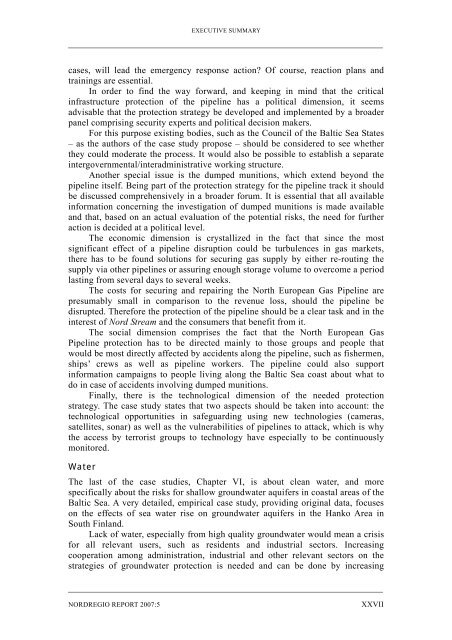Towards a Baltic Sea Region Strategy in Critical ... - Helsinki.fi
Towards a Baltic Sea Region Strategy in Critical ... - Helsinki.fi
Towards a Baltic Sea Region Strategy in Critical ... - Helsinki.fi
Create successful ePaper yourself
Turn your PDF publications into a flip-book with our unique Google optimized e-Paper software.
EXECUTIVE SUMMARY<br />
cases, will lead the emergency response action? Of course, reaction plans and<br />
tra<strong>in</strong><strong>in</strong>gs are essential.<br />
In order to f<strong>in</strong>d the way forward, and keep<strong>in</strong>g <strong>in</strong> m<strong>in</strong>d that the critical<br />
<strong>in</strong>frastructure protection of the pipel<strong>in</strong>e has a political dimension, it seems<br />
advisable that the protection strategy be developed and implemented by a broader<br />
panel compris<strong>in</strong>g security experts and political decision makers.<br />
For this purpose exist<strong>in</strong>g bodies, such as the Council of the <strong>Baltic</strong> <strong>Sea</strong> States<br />
– as the authors of the case study propose – should be considered to see whether<br />
they could moderate the process. It would also be possible to establish a separate<br />
<strong>in</strong>tergovernmental/<strong>in</strong>teradm<strong>in</strong>istrative work<strong>in</strong>g structure.<br />
Another special issue is the dumped munitions, which extend beyond the<br />
pipel<strong>in</strong>e itself. Be<strong>in</strong>g part of the protection strategy for the pipel<strong>in</strong>e track it should<br />
be discussed comprehensively <strong>in</strong> a broader forum. It is essential that all available<br />
<strong>in</strong>formation concern<strong>in</strong>g the <strong>in</strong>vestigation of dumped munitions is made available<br />
and that, based on an actual evaluation of the potential risks, the need for further<br />
action is decided at a political level.<br />
The economic dimension is crystallized <strong>in</strong> the fact that s<strong>in</strong>ce the most<br />
signi<strong>fi</strong>cant effect of a pipel<strong>in</strong>e disruption could be turbulences <strong>in</strong> gas markets,<br />
there has to be found solutions for secur<strong>in</strong>g gas supply by either re-rout<strong>in</strong>g the<br />
supply via other pipel<strong>in</strong>es or assur<strong>in</strong>g enough storage volume to overcome a period<br />
last<strong>in</strong>g from several days to several weeks.<br />
The costs for secur<strong>in</strong>g and repair<strong>in</strong>g the North European Gas Pipel<strong>in</strong>e are<br />
presumably small <strong>in</strong> comparison to the revenue loss, should the pipel<strong>in</strong>e be<br />
disrupted. Therefore the protection of the pipel<strong>in</strong>e should be a clear task and <strong>in</strong> the<br />
<strong>in</strong>terest of Nord Stream and the consumers that bene<strong>fi</strong>t from it.<br />
The social dimension comprises the fact that the North European Gas<br />
Pipel<strong>in</strong>e protection has to be directed ma<strong>in</strong>ly to those groups and people that<br />
would be most directly affected by accidents along the pipel<strong>in</strong>e, such as <strong>fi</strong>shermen,<br />
ships’ crews as well as pipel<strong>in</strong>e workers. The pipel<strong>in</strong>e could also support<br />
<strong>in</strong>formation campaigns to people liv<strong>in</strong>g along the <strong>Baltic</strong> <strong>Sea</strong> coast about what to<br />
do <strong>in</strong> case of accidents <strong>in</strong>volv<strong>in</strong>g dumped munitions.<br />
F<strong>in</strong>ally, there is the technological dimension of the needed protection<br />
strategy. The case study states that two aspects should be taken <strong>in</strong>to account: the<br />
technological opportunities <strong>in</strong> safeguard<strong>in</strong>g us<strong>in</strong>g new technologies (cameras,<br />
satellites, sonar) as well as the vulnerabilities of pipel<strong>in</strong>es to attack, which is why<br />
the access by terrorist groups to technology have especially to be cont<strong>in</strong>uously<br />
monitored.<br />
Water<br />
The last of the case studies, Chapter VI, is about clean water, and more<br />
speci<strong>fi</strong>cally about the risks for shallow groundwater aquifers <strong>in</strong> coastal areas of the<br />
<strong>Baltic</strong> <strong>Sea</strong>. A very detailed, empirical case study, provid<strong>in</strong>g orig<strong>in</strong>al data, focuses<br />
on the effects of sea water rise on groundwater aquifers <strong>in</strong> the Hanko Area <strong>in</strong><br />
South F<strong>in</strong>land.<br />
Lack of water, especially from high quality groundwater would mean a crisis<br />
for all relevant users, such as residents and <strong>in</strong>dustrial sectors. Increas<strong>in</strong>g<br />
cooperation among adm<strong>in</strong>istration, <strong>in</strong>dustrial and other relevant sectors on the<br />
strategies of groundwater protection is needed and can be done by <strong>in</strong>creas<strong>in</strong>g<br />
NORDREGIO REPORT 2007:5<br />
XXVII

















